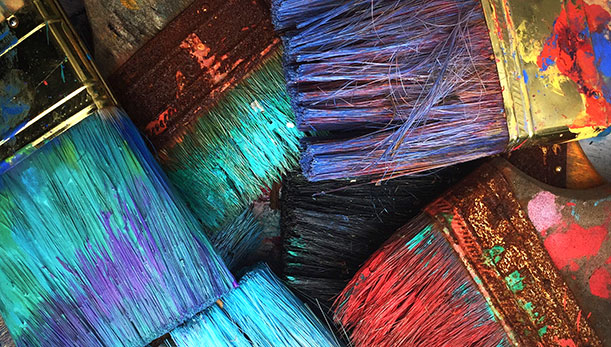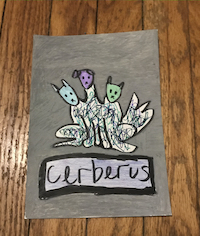BOOMbox at Home: Ingredients of Art
February 2, 2021

Supplies
Historically, art supplies have had some pretty strange ingredients: lead, mummies, cow urine, and more. Even today, bugs are used. Fortunately, there are also simpler options, including some that you can make at home. You can actually make everything you need for a painting project. Next week's BOOMbox at Home blog post will show how to make your own paper.
Anything you can use to make marks on paper can be used as a brush. Fabric, plant scraps, food, hair, and more can all be made into paintbrushes. Using a clothespin as a handle, experiment with different materials to find your favorite.
There are lots of ways to make your own paint, but some of the easiest options are also…the tastiest? It isn't a great idea to mix art supplies and snacks, but you can make paint with ingredients from your kitchen. These paints may not last as long as the ones you’d buy at a store, but they’re great options for younger kids or around pets since they’re made with edible ingredients. For a thick paint for finger painting, use yogurt or pudding to make paint. If you’d prefer a glossy finish, try condensed milk for paintings inspired by stained glass windows.
For sculpture, make your own kinetic sand. This material is great for both 3-dimensional art and abstract sensory play. You may need to buy a bag of sand from your local hardware store, but the ingredients for this project will go a long way.
Style and Subject Matter
Imagine you’re listening to music and you hear a great new song. Even though you’ve never heard it before, you can immediately recognize that it’s by your favorite band. How? All artists, regardless of the media they use, have a distinctive style that makes their art uniquely theirs. An artist’s style is made up of lots of small features that show up repeatedly in their works.

Explore the role of style in art by imitating the style of another artist. Take a virtual museum tour or scroll through the Instagram feed or blog of an artist you like. What stands out to you? What are some of the things you like about their work? After taking notes on their style, try incorporating those elements in your own art. For example, Eli tried to imitate the art of Pendleton Ward, the creator of Adventure Time. The characters feature simplified faces with dots for eyes and no noses, noodle-y limbs, and large blocks of color with little or no shading. Eli drew some characters incorporating these aspects.
An individual artist may have several pieces in the same style but with different subject matter, and other artists may depict the same subjects using different methods, applying their style to make a piece their own. For example, you’ve probably seen several different versions of myths, fairy tales, and classic stories. Did you know that even The Lion King was based on a Shakespeare play?

Eli made this doodle inspired by Cerberus, a three-headed dog from Greek mythology, using markers and paint pens. Try making your own version of Cerberus. You could draw or paint a picture, make a collage or sculpture, write a story or poem, or make any other type of art you like. Is your Cerberus cute or scary? Does it look like a normal dog, or does it have a more magical appearance? Do the heads get along or fight? The choices you make are key ingredients in your piece.
Ingredients of a Portrait
Have you ever seen what looks like a face in the front of a car or in a cloud? Or perhaps you’ve noticed that blueberry muffins sometimes look awfully similar to Chihuahuas. We seem to be surrounded by faces. The Faces in Things Twitter account has some fun examples. In fact, our brains are primed to see faces. Recognizing faces helps us form social relationships and identify potential predators--skills that would have been big evolutionary advantages for our ancestors.
The fusiform face area is the part of our brains responsible for recognizing faces. In order to quickly process everything we see, our brains use techniques like grouping and top-down processing. Combined, these factors mean that it’s pretty common for us to overgeneralize and find faces in inanimate objects. This phenomenon is called pareidolia.
Try it by going on a scavenger hunt for faces in your home or neighborhood. Photograph as many as you can find. What are the basic elements you need for something to look like a face? For a bonus challenge, try drawing some abstract faces and then ask a friend or family member what they see. How many features can you remove or distort before it no longer looks like a face? Can you make a face with just one line? How about making fun faces with food?
Ingredient of the Week
Pudding is a really useful ingredient to have at home. In addition to making edible paint, pudding also makes delicious french toast. Try this french toast recipe that uses vanilla pudding mix for your next decadent breakfast (or lunch or dinner).
Artist of the Week
Cyrus Kabiru is a self-taught Kenyan artist who uses recycled materials to create sculptures and mixed-media pieces. Some of his most recognized works are his spectacle sculptures, which are themed around Black perspectives and visions of Black futures. His art has been featured in exhibitions in 10 countries throughout Africa, North America, and Europe.
Written by Eli, Pam, and Michelle.